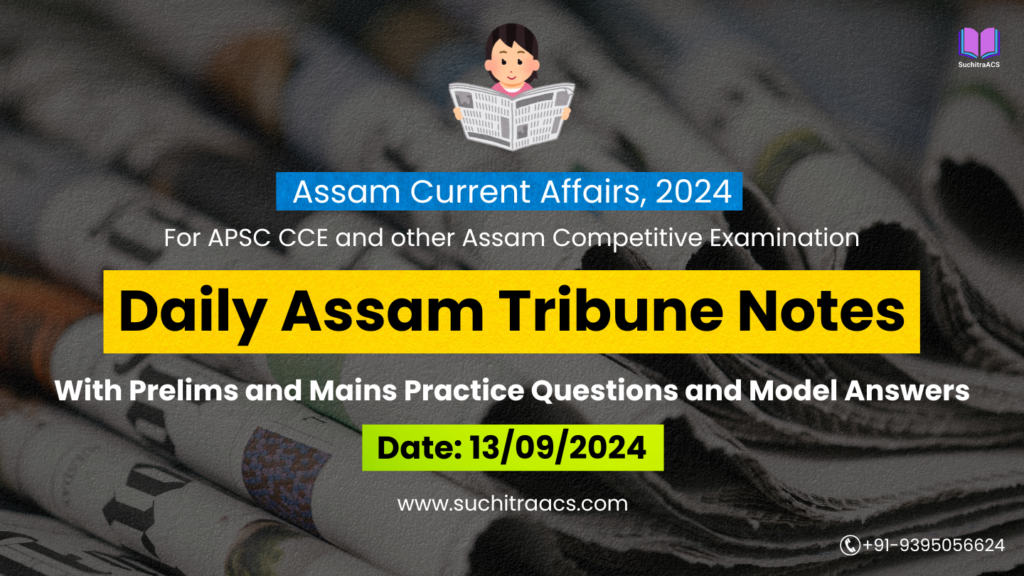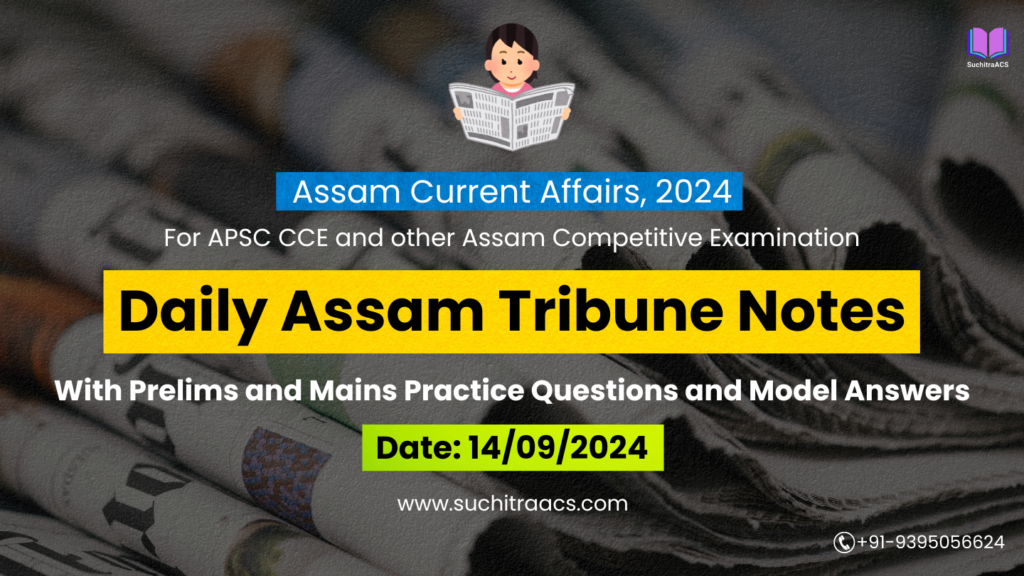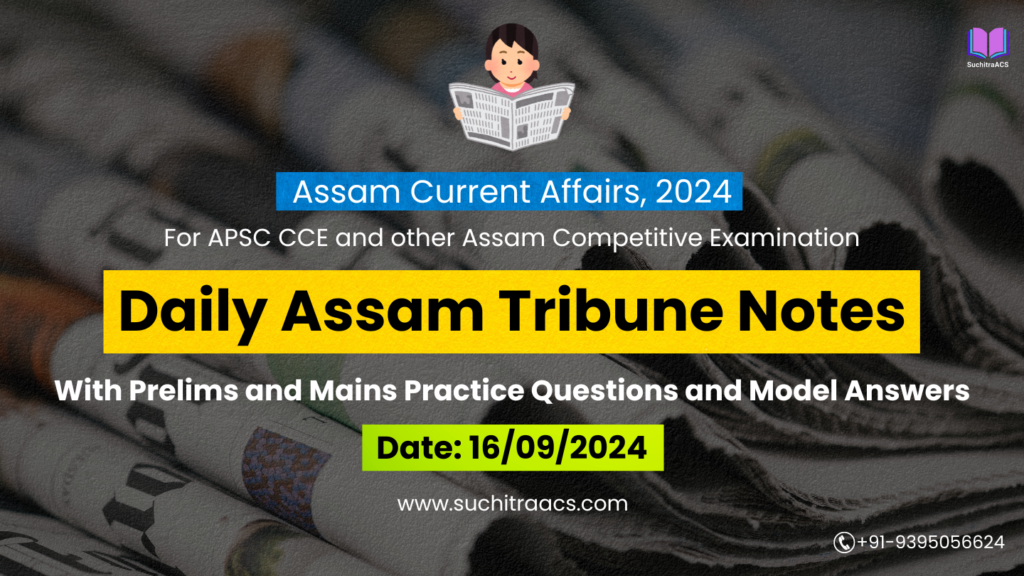APSC Current Affairs: Assam Tribune Notes with MCQs and Answer Writing (02/05/2025)
For APSC CCE and other Assam Competitive examinations aspirants, staying updated with current affairs is vital. This blog covers most important topics from the Assam Tribune today (02-05-2025). These issues are key for both APSC Prelims and Mains preparation, offering insights into the APSC CCE Syllabus.
✨ Current Affairs Crash Course for the APSC Prelims 2025

🇮🇳 Upendranath Brahma Honoured in Delhi: A Milestone in Bodo Identity Assertion
📘 GS Paper 1: Indian Society | Role of Social Reformers
📘 GS Paper 2: Government Policies | Minority Rights | Federalism
🔹 Introduction
In a landmark gesture, the Centre unveiled a statue of Upendranath Brahma, revered as Bodofa, in New Delhi, and renamed a road after him. This move aligns with the government’s broader strategy of mainstreaming Northeast icons and underscores the Bodo identity in the national narrative.
🔑 Key Highlights
| Aspect | Details |
| Event | Unveiling of Bodofa Upendranath Brahma’s statue in Delhi |
| Road Renamed | Stretch of Lala Lajpat Rai Marg |
| Occasion | 35th Death Anniversary of Upendranath Brahma |
| Announced By | Union Home Minister Amit Shah |
| State Involvement | Assam CM Himanta Biswa Sarma attended the event |
| Historical Context | Signatory figure of Bodo socio-political movement; “Father of the Bodos” |
🧠 Prelims Pointers
Upendranath Brahma: An educator and president of the All Bodo Students’ Union (ABSU); initiated the “Divide Assam 50:50” demand.
Bodo Peace Accord (2020): Signed between the Centre, Assam Government, and Bodo groups (e.g. NDFB); led to creation of Bodoland Territorial Region (BTR).
BTC & BTR: Autonomous body under Sixth Schedule; BTC governed Bodoland until replaced by BTR.
Bodofa Day: Observed on May 1 every year to commemorate Brahma’s legacy.
📝 Mains Pointers
A. Significance of the Move
Cultural Inclusion: Boosts representation of Northeast icons in national consciousness.
Federal Recognition: Emphasizes Centre-State synergy in acknowledging regional histories.
Bodo Identity: Reinforces ethnic pride, aligns with peace-building post-insurgency.
B. Challenges in Bodo Integration
| Challenge | Explanation |
| Identity Politics | Lingering tensions between Bodos and non-Bodo communities in BTR |
| Development Deficit | Despite peace, region struggles with poor infrastructure and joblessness |
| Institutional Gaps | Need for capacity-building in BTC governance, budget implementation |
C. Government Initiatives
Implementation of 96% of the clauses of the 2020 Bodo Accord
Creation of BTR Welfare Council for non-Bodo tribals
Skill development, education and tourism projects in BTR under central schemes
D. Way Forward
Promote inclusive governance in BTR through proportional representation
Strengthen peace dividends via development in education, health, and skill sectors
Launch academic and cultural exchanges to mainstream Northeast identities
🧩 Conclusion
The national recognition of Bodofa reflects an important turn in the Centre’s approach to Northeast India—where integration meets identity assertion. This symbolism must translate into policy support, inclusion, and equitable development for long-term peace and harmony.
🧪 ICMR Transfers Indigenous TB Detection Tech for Mass Use
📘 GS Paper 2: Health | Government Policies | Science & Tech
📘 GS Paper 3: Disease Control | Innovation & R&D | Public Health
🔹 Introduction
In a significant stride toward “TB Mukt Bharat”, the ICMR-Regional Medical Research Centre (RMRC-NE), Dibrugarh transferred its indigenously developed CRISPR-based TB diagnostic system to a private firm for commercial production. This innovation reflects the growing synergy between scientific innovation and public health goals in India’s disease elimination programs.
🔑 Key Features
| Feature | Description |
| Institution | ICMR–RMRC, North East (Dibrugarh) |
| Technology | CRISPR-Cas-based ultra-sensitive molecular diagnostic tool |
| Purpose | Rapid and point-of-care TB detection, particularly in underserved areas |
| Partner Firm | Meril Diagnostics Pvt. Ltd. |
| Transfer Mechanism | Formal Memorandum of Agreement (MoA) signed |
| Goal | Support India’s 2025 TB Elimination Mission |
🧠 Prelims Pointers
CRISPR-Cas9: A gene-editing tool adapted here for diagnostic use (called CRISPR-Dx).
ICMR: Apex body under the Ministry of Health and Family Welfare for biomedical research.
Point-of-Care Diagnostics: On-site disease testing with rapid results, critical for rural areas.
TB Elimination Target: India aims to eliminate TB by 2025 (5 years ahead of global SDG).
RMRC-NE: Regional hub for disease research; key institute under ICMR in Assam.
📝 Mains Pointers
A. Significance
| Area | Impact |
| Early Detection | Enables faster TB diagnosis in rural/tribal areas |
| Self-Reliance | ‘Make in India’ innovation for disease diagnostics |
| Cost-Effective Public Health | Reduces diagnostic burden and delays |
| Scaling Strategy | Adaptable to other infectious diseases in future |
B. Challenges
| Challenge | Explanation |
| Field Implementation | Requires cold chain and trained workers |
| Awareness Gap | Community reluctance due to stigma and ignorance |
| Private Integration | Balancing affordability with commercialization |
| R&D Funding | Sustaining research beyond pilot phase |
📊 Related Initiatives
National Strategic Plan for TB Elimination (2017–2025)
Ni-Kshay Platform: Real-time TB case monitoring and service tracking
Private Sector Engagement: Incentives for private labs and clinics to notify and treat TB
Digital Health Mission: Can integrate TB diagnostics into digital health records
🧭 Way Forward
🔬 Scale-up via Health & Wellness Centres under Ayushman Bharat
📡 Train ASHA & ANM workers in sample collection and test operation
🤝 Public-Private Partnerships for low-cost, high-volume deployment
📈 Monitoring & Feedback Loop via Ni-Kshay and district TB cells
💰 CSR and Innovation Funds to expand indigenous diagnostic R&D
🧩 Conclusion
India’s ambitious TB elimination goal requires a robust and decentralized diagnosis network. The CRISPR-based solution from ICMR-Dibrugarh is not just a technological feat—it is a lifeline for last-mile health equity, especially in underserved Northeast and tribal regions. A well-supported scale-up will determine whether this innovation truly becomes a game-changer in India’s public health narrative.
🔧 Gas Leak at OIL Pipeline: Industrial Safety and Environmental Risk in Assam
📘 GS Paper 3: Disaster Management | Environment & Ecology | Industrial Safety
📘 GS Paper 2: Governance | Regulatory Institutions | Local Administration
🔹 Introduction
A gas leakage incident from an Oil India Limited (OIL) pipeline in Nagajan, Makum (Tinsukia district), caused panic among residents, raising concerns over industrial safety protocols and environmental risk management in Assam’s oil-rich regions. The incident draws attention to the persistent challenges of managing aging infrastructure and emergency preparedness in India’s energy sector.
🔑 Key Details
| Aspect | Description |
| Location | Nagajan, Makum (Tinsukia district), Assam |
| Company Involved | Oil India Limited (OIL) |
| Incident | Gas leak from well No. 309 due to valve breakdown |
| Emergency Response | Fire safety teams from OIL, AGCL, and BCPL deployed |
| Duration | Estimated 2–3 days to fully control the situation |
| Public Impact | Evacuation warning and panic among residents |
🧠 Prelims Pointers
Oil India Limited (OIL): PSU under the Ministry of Petroleum; head office in Duliajan, Assam.
Makum & Digboi: Historically significant oil-producing regions in Assam.
Disaster Management Act, 2005: Governs emergency response to industrial accidents.
Environmental Impact Assessment (EIA): Mandatory for oil and gas extraction under MoEFCC.
BCPL: Brahmaputra Cracker and Polymer Limited – major petrochemical plant near the site.
📝 Mains Pointers
A. Significance of the Issue
| Significance | Explanation |
| Energy Security | Assam contributes significantly to India’s domestic oil production |
| Human Safety | High-risk zones in inhabited areas demand strict compliance |
| Ecological Fragility | Makum is close to Dehing Patkai rainforest and wetland systems |
| Industrial Accountability | Highlights gaps in proactive maintenance and real-time monitoring |
B. Challenges
| Challenge | Description |
| Aging Infrastructure | Many pipelines and wells are decades old |
| Lack of Real-Time Monitoring | Delayed detection worsens damage potential |
| Poor Public Awareness | Communities unaware of emergency evacuation protocols |
| Overlapping Jurisdictions | State, OIL, and environmental authorities often work in silos |
C. Policy & Institutional Framework
Petroleum and Natural Gas Regulatory Board (PNGRB) – Sets safety standards for upstream oil infrastructure.
State Pollution Control Boards – Responsible for monitoring environmental compliance.
Oil Industry Safety Directorate (OISD) – Frames safety norms and conducts audits.
District Disaster Management Authority (DDMA) – Local response body under the DM Act, 2005.
D. Way Forward
🛰️ Sensor-Based Monitoring: Use IoT-based leak detection systems
📢 Community Awareness Drives: Annual drills and safety literacy programs
🔍 Third-Party Audits: Independent safety assessments of all oil installations
📊 Incident Transparency: Timely disclosure of leaks and hazards
🤝 CSR for Environment: OIL must invest in local environmental restoration
🧩 Conclusion
This gas leak serves as a wake-up call to strengthen Assam’s industrial risk governance. In a state rich in hydrocarbons but also ecologically sensitive, balancing economic benefits with environmental and public safety is essential for sustainable resource governance.
🗳️ First Phase of Panchayat Polls in Assam: Testing Grassroots Democracy
📘 GS Paper 2: Polity | Local Governance | Electoral Reforms
📘 GS Paper 1: Indian Society | Decentralization
🔹 Introduction
The first phase of Panchayat elections began across various districts of Assam including Sivasagar, Golaghat, Majuli, and Cachar, involving lakhs of voters and thousands of candidates. The elections serve as a test for local governance, women’s representation, and administrative preparedness in Assam’s rural areas.
🔑 Key Details
| Feature | Description |
| Districts Covered | Jorhat, Sivasagar, Majuli, Golaghat, Cachar |
| Total Voters (Jorhat) | 6,00,773 |
| Candidates in Fray (Jorhat) | 2,190 (ZPCs, APs, GPs) |
| Uncontested Seats | 11 candidates already elected unopposed in some wards |
| All-Women Booths | 228 booths run entirely by women officials (Golaghat) |
| Election Postponement | Betbari GP (Sivasagar) postponed due to candidate death |
| Supervisory Visits | DCs personally reviewed logistics and food quality for staff |
🧠 Prelims Pointers
Three-Tier Panchayati Raj: Zila Parishad (ZP), Anchalik Panchayat (AP), Gaon Panchayat (GP).
73rd Constitutional Amendment (1992): Established Panchayati Raj institutions (PRIs) in rural India.
Article 243G: Empowers Panchayats with economic development and social justice functions.
State Election Commission (SEC): Conducts PRI elections under Article 243K.
Reservation in PRIs: One-third seats reserved for women (including SC/ST categories).
📝 Mains Pointers
A. Significance of Panchayat Elections
| Dimension | Relevance |
| Democratic Decentralization | Brings governance to grassroots; citizen-centric development |
| Women Empowerment | Boosts participation through reserved all-women booths and candidacies |
| Local Accountability | Elected officials held responsible for rural welfare and service delivery |
| Political Training Ground | Grooming for higher political leadership begins at local levels |
B. Challenges in Conduct and Governance
| Challenge | Details |
| Election Management | Logistics in remote areas and heatwave impact on staff turnout |
| Violence & Booth Capturing | Sporadic incidents reported in previous elections |
| Low Awareness | Voter illiteracy and disinterest in GP-level governance |
| Delayed Elections | Often postponed due to floods, legal delays, or administrative gaps |
🧭 Way Forward
🗂 Digitized Voter Lists & Booth Mapping to ensure fair polls
🧕 Capacity Building of Women Representatives for effective leadership
🛣️ Improve Rural Infrastructure for polling logistics and post-election implementation
📢 Civic Education drives to promote PRI awareness and voter participation
🏛️ Devolution of Funds, Functions, Functionaries (3Fs) to empower local bodies
🧩 Conclusion
The Panchayat elections are not just routine democratic exercises but an indicator of how well decentralization and participatory governance function on the ground in Assam. Successful conduct and follow-up action will determine how effectively rural aspirations are translated into tangible development.
APSC Prelims Practice Questions
🧑🏫 Topic 1: Upendranath Brahma & Bodo Identity
Q1. Upendranath Brahma, recently honoured in New Delhi, is associated with:
A. Nagaland insurgency movement
B. Bodoland movement and Bodo socio-political upliftment
C. Assamese linguistic identity movement
D. Tribal land rights in Manipur
✅ Answer: B
🧠 Explanation: Upendranath Brahma is regarded as the “Father of the Bodos” and led peaceful socio-political mobilization for Bodo autonomy.
Q2. The Bodoland Territorial Region (BTR) was created under which agreement?
A. Assam Accord, 1985
B. Bodo Accord, 2020
C. North East Peace Accord, 2003
D. Sixth Schedule Reform Act, 2011
✅ Answer: B
🧠 Explanation: The BTR was formed under the 2020 Bodo Peace Accord, signed between the Centre, Assam Government, and Bodo groups.
🧪 Topic 2: ICMR TB Diagnostic (CRISPR)
Q3. CRISPR technology, used in TB diagnosis by ICMR-RMRC Dibrugarh, primarily functions as:
A. A radiation therapy system
B. A robotic surgical assistant
C. A gene-editing and detection tool
D. A protein sequencing method
✅ Answer: C
🧠 Explanation: CRISPR (Clustered Regularly Interspaced Short Palindromic Repeats) is a gene-editing and now diagnostic tool used to detect pathogens like TB with high precision.
Q4. What is the main objective of the ‘Ni-Kshay’ portal in India’s TB elimination program?
A. Subsidizing TB drugs
B. Real-time tracking of TB patients
C. Certifying rural health workers
D. Monitoring air quality in TB-prone zones
✅ Answer: B
🧠 Explanation: The Ni-Kshay portal is a national TB surveillance system that tracks case notification, treatment, and progress in real time.
🔧 Topic 3: OIL Pipeline Gas Leak
Q5. Which of the following institutions regulates safety standards for India’s oil and gas sector?
- Oil Industry Safety Directorate (OISD)
- Petroleum and Natural Gas Regulatory Board (PNGRB)
- National Disaster Response Force (NDRF)
- State Pollution Control Boards
A. 1 and 2 only
B. 2 and 3 only
C. 1, 2 and 4 only
D. All of the above
✅ Answer: C
🧠 Explanation: OISD and PNGRB set industrial safety norms; State PCBs ensure environmental compliance. NDRF is a response agency, not a regulator.
Q6. The Disaster Management Act, 2005 provides for:
A. Establishment of the Environment Protection Agency
B. Constitutional status to DDMA
C. Creation of District Disaster Management Authorities (DDMAs)
D. Central command over law and order during disasters
✅ Answer: C
🧠 Explanation: The DM Act created DDMAs in every district for local-level disaster mitigation and response.
🗳️ Topic 4: Panchayat Elections in Assam
Q7. Which of the following provisions relate to Panchayati Raj in India?
- Article 243
- Article 280
- Article 243K
- 73rd Constitutional Amendment
A. 1, 3 and 4 only
B. 2 and 3 only
C. 1 and 2 only
D. All of the above
✅ Answer: A
🧠 Explanation: Articles 243 to 243O deal with Panchayati Raj. Article 280 relates to the Finance Commission, not PRIs.
Q8. In Panchayat elections, which body is responsible for conducting free and fair polls in the states?
A. Election Commission of India
B. State Election Commission
C. National Panchayati Raj Council
D. Ministry of Rural Development
✅ Answer: B
🧠 Explanation: The State Election Commission (SEC), under Article 243K, conducts Panchayat and municipal elections.
APSC Mains Practice Question
📝 Mains Question (GS Paper 2 – Governance | Health | Innovation)
“The transfer of indigenous CRISPR-based TB diagnostic technology by ICMR represents a turning point in India’s battle against tuberculosis. Discuss the significance of this innovation for public health, especially in underserved regions.”
🔹 Introduction
Tuberculosis (TB) remains one of India’s most persistent public health challenges, accounting for nearly 25% of the global TB burden. The recent move by ICMR-Regional Medical Research Centre (RMRC), Dibrugarh, to commercialize a CRISPR-based TB detection system marks a bold step toward tech-led health equity in the fight for a “TB Mukt Bharat” by 2025.
🔹 Why CRISPR-Based TB Diagnostics Matter
| Parameter | Benefit |
| Speed | Delivers results within 30–60 minutes |
| Accuracy | High sensitivity & specificity for early detection |
| Portability | Suitable for rural/tribal areas lacking advanced labs |
| Affordability | Low-cost alternative to GeneXpert and culture-based methods |
🔹 Public Health Significance
- Decentralized Diagnosis
- Ensures point-of-care testing, crucial in the Northeast and remote tribal belts
- Bridges urban-rural diagnostic divide
- Enables Early Treatment
- Prevents disease transmission and reduces mortality
- Reduces loss to follow-up due to rapid results
- Make in India & Health Sovereignty
- Reduces dependence on imported diagnostic kits
- Builds R&D capacity in Tier-2 cities like Dibrugarh
- Supports National TB Elimination Mission (2025)
- Complements initiatives like Ni-Kshay, Nikshay Mitra, and free drug regimens
🔹 Challenges to Address
| Challenge | Explanation |
| Logistics | Cold chain for reagents, trained personnel for test handling |
| Scale & Speed | Slow integration into government health systems |
| Affordability Concerns | Risk of pricing out diagnostics if monopolized |
| Monitoring & Evaluation | Need for digital integration with Ni-Kshay for tracking |
🔹 Policy & Institutional Support Needed
- Ayushman Bharat Health & Wellness Centres (HWCs) can serve as distribution and testing hubs
- Public-Private Partnerships for manufacturing, training, and deployment
- Integration with Digital Health Stack under National Health Mission
- Funding via CSR and Health Innovation Funds to accelerate adoption in underserved districts
🔹 Way Forward
- 🧑⚕️ Train ASHA & ANM workers to collect and handle TB samples
- 🛰️ Use of telemedicine to link patients in remote areas with doctors
- 📊 Real-time data dashboard for test outcomes and coverage gaps
- 🔬 Expand use of CRISPR to other diseases (e.g., dengue, malaria) in endemic regions
🔹 Conclusion
The CRISPR-based TB diagnostic system is a game-changer for India’s public health infrastructure—particularly for underserved populations in the Northeast. If scaled equitably and supported by robust policy and funding, it can turn India’s TB elimination dream into a data-driven, tech-enabled reality.
✨ APSC Prelims Crash Course, 2025

🔔 Join Our WhatsApp Study Group!
For exclusive access to premium quality content, including study materials, current affairs, MCQs, and model answers for APSC CCE and other Assam competitive exams.
Click here to join: SuchitraACS Study WhatsApp Group
📚 Want to know more about SuchitraACS’s most affordable courses?
Click here to know more: SuchitraACS Courses for APSC CCE and Assam Competitive Examinations




